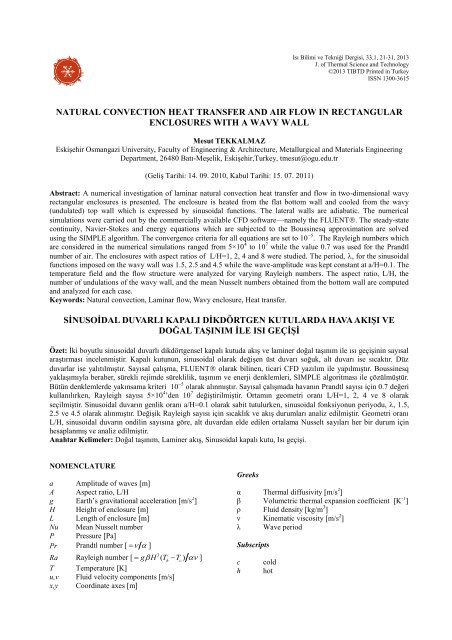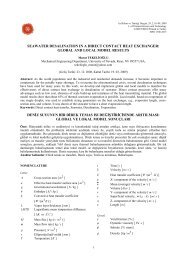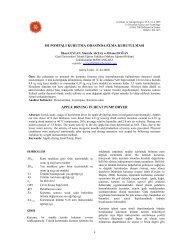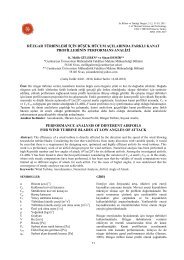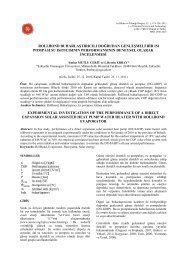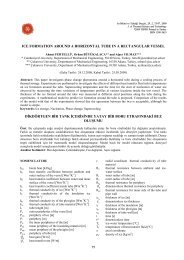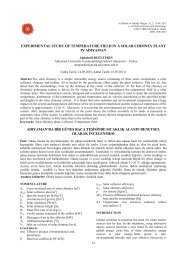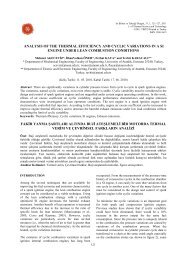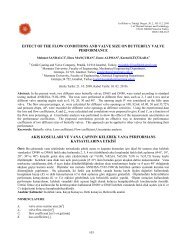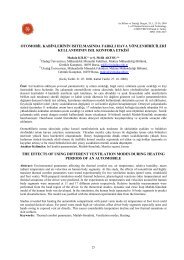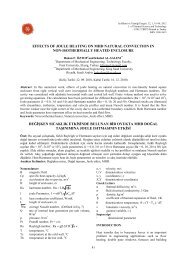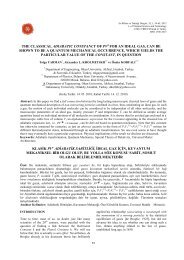natural convection heat transfer and air flow in rectangular ...
natural convection heat transfer and air flow in rectangular ...
natural convection heat transfer and air flow in rectangular ...
You also want an ePaper? Increase the reach of your titles
YUMPU automatically turns print PDFs into web optimized ePapers that Google loves.
Isı Bilimi ve Tekniği Dergisi, 33,1, 21-31, 2013<br />
J. of Thermal Science <strong>and</strong> Technology<br />
©2013 TIBTD Pr<strong>in</strong>ted <strong>in</strong> Turkey<br />
ISSN 1300-3615<br />
NATURAL CONVECTION HEAT TRANSFER AND AIR FLOW IN RECTANGULAR<br />
ENCLOSURES WITH A WAVY WALL<br />
Mesut TEKKALMAZ<br />
Eskişehir Osmangazi University, Faculty of Eng<strong>in</strong>eer<strong>in</strong>g & Architecture, Metallurgical <strong>and</strong> Materials Eng<strong>in</strong>eer<strong>in</strong>g<br />
Department, 26480 Batı-Meşelik, Eskişehir,Turkey, tmesut@ogu.edu.tr<br />
(Geliş Tarihi: 14. 09. 2010, Kabul Tarihi: 15. 07. 2011)<br />
Abstract: A numerical <strong>in</strong>vestigation of lam<strong>in</strong>ar <strong>natural</strong> <strong>convection</strong> <strong>heat</strong> <strong>transfer</strong> <strong>and</strong> <strong>flow</strong> <strong>in</strong> two-dimensional wavy<br />
<strong>rectangular</strong> enclosures is presented. The enclosure is <strong>heat</strong>ed from the flat bottom wall <strong>and</strong> cooled from the wavy<br />
(undulated) top wall which is expressed by s<strong>in</strong>usoidal functions. The lateral walls are adiabatic. The numerical<br />
simulations were carried out by the commercially available CFD software—namely the FLUENT. The steady-state<br />
cont<strong>in</strong>uity, Navier-Stokes <strong>and</strong> energy equations which are subjected to the Bouss<strong>in</strong>esq approximation are solved<br />
us<strong>in</strong>g the SIMPLE algorithm. The convergence criteria for all equations are set to 10 5 . The Rayleigh numbers which<br />
are considered <strong>in</strong> the numerical simulations ranged from 5×10 4 to 10 7 while the value 0.7 was used for the Pr<strong>and</strong>tl<br />
number of <strong>air</strong>. The enclosures with aspect ratios of L/H=1, 2, 4 <strong>and</strong> 8 were studied. The period, , for the s<strong>in</strong>usoidal<br />
functions imposed on the wavy wall was 1.5, 2.5 <strong>and</strong> 4.5 while the wave-amplitude was kept constant at a/H=0.1. The<br />
temperature field <strong>and</strong> the <strong>flow</strong> structure were analyzed for vary<strong>in</strong>g Rayleigh numbers. The aspect ratio, L/H, the<br />
number of undulations of the wavy wall, <strong>and</strong> the mean Nusselt numbers obta<strong>in</strong>ed from the bottom wall are computed<br />
<strong>and</strong> analyzed for each case.<br />
Keywords: Natural <strong>convection</strong>, Lam<strong>in</strong>ar <strong>flow</strong>, Wavy enclosure, Heat <strong>transfer</strong>.<br />
SİNUSOİDAL DUVARLI KAPALI DİKDÖRTGEN KUTULARDA HAVA AKIŞI VE<br />
DOĞAL TAŞINIM İLE ISI GEÇİŞİ<br />
Özet: İki boyutlu s<strong>in</strong>usoidal duvarlı dikdörtgensel kapalı kutuda akış ve lam<strong>in</strong>er doğal taşınım ile ısı geçiş<strong>in</strong><strong>in</strong> sayısal<br />
araştırması <strong>in</strong>celenmiştir. Kapalı kutunun, s<strong>in</strong>usoidal olarak değişen üst duvarı soğuk, alt duvarı ise sıcaktır. Düz<br />
duvarlar ise yalıtılmıştır. Sayısal çalışma, FLUENT olarak bil<strong>in</strong>en, ticari CFD yazılım ile yapılmıştır. Bouss<strong>in</strong>esq<br />
yaklaşımıyla beraber, sürekli rejimde süreklilik, taşınım ve enerji denklemleri, SIMPLE algoritması ile çözülmüştür.<br />
Bütün denklemlerde yakınsama kriteri 10 5 olarak alınmıştır. Sayısal çalışmada havanın Pr<strong>and</strong>tl sayısı iç<strong>in</strong> 0.7 değeri<br />
kullanılırken, Rayleigh sayısı 5×10 4 ’den 10 7 değiştirilmiştir. Ortamın geometri oranı L/H=1, 2, 4 ve 8 olarak<br />
seçilmiştir. S<strong>in</strong>usoidal duvarın genlik oranı a/H=0.1 olarak sabit tutulurken, s<strong>in</strong>usoidal fonksiyonun periyodu, , 1.5,<br />
2.5 ve 4.5 olarak alınmıştır. Değişik Rayleigh sayısı iç<strong>in</strong> sıcaklık ve akış durumları analiz edilmiştir. Geometri oranı<br />
L/H, s<strong>in</strong>usoidal duvarın ondil<strong>in</strong> sayısına göre, alt duvardan elde edilen ortalama Nusselt sayıları her bir durum iç<strong>in</strong><br />
hesaplanmış ve analiz edilmiştir.<br />
Anahtar Kelimeler: Doğal taşınım, Lam<strong>in</strong>er akış, S<strong>in</strong>usoidal kapalı kutu, Isı geçişi.<br />
NOMENCLATURE<br />
a Amplitude of waves [m]<br />
A Aspect ratio, L/H<br />
g Earth’s gravitational acceleration [m/s 2 ]<br />
H Height of enclosure [m]<br />
L Length of enclosure [m]<br />
Nu Mean Nusselt number<br />
P Pressure [Pa]<br />
Pr Pr<strong>and</strong>tl number [ ]<br />
Ra Rayleigh number [ g<br />
H 3 ( Th<br />
Tc)<br />
]<br />
T Temperature [K]<br />
u,v Fluid velocity components [m/s]<br />
x,y Coord<strong>in</strong>ate axes [m]<br />
Greeks<br />
α Thermal diffusivity [m/s 2 ]<br />
β Volumetric thermal expansion coefficient [K -1 ]<br />
ρ Fluid density [kg/m 3 ]<br />
ν K<strong>in</strong>ematic viscosity [m/s 2 ]<br />
λ Wave period<br />
Subscripts<br />
c<br />
h<br />
cold<br />
hot
INTRODUCTION<br />
The <strong>natural</strong> <strong>convection</strong> <strong>in</strong> fluid filled <strong>rectangular</strong><br />
enclosures has received considerable attention <strong>in</strong> recent<br />
years because of its relation to the thermal performance<br />
of eng<strong>in</strong>eer<strong>in</strong>g applications. The <strong>natural</strong> <strong>convection</strong> <strong>heat</strong><br />
<strong>transfer</strong> from wavy surface is <strong>in</strong>terest of several<br />
eng<strong>in</strong>eer<strong>in</strong>g applications such as cool<strong>in</strong>g of electronic<br />
components <strong>and</strong> sealed electrical <strong>and</strong>/or electronic<br />
boxes, <strong>heat</strong><strong>in</strong>g <strong>and</strong> cool<strong>in</strong>g rooms, solar energy collector<br />
designs, <strong>heat</strong> exchanger designs so on. Thus, the<br />
characteristics of <strong>natural</strong> <strong>convection</strong> <strong>heat</strong> <strong>transfer</strong> are<br />
relatively important.<br />
Yao (1983) theoretically studied the <strong>natural</strong> <strong>convection</strong><br />
along a vertical wavy surface. He found that the local<br />
<strong>heat</strong> <strong>transfer</strong> rate is smaller than that of a flat plate case,<br />
<strong>and</strong> the <strong>heat</strong> <strong>transfer</strong> decreased with <strong>in</strong>creas<strong>in</strong>g waveamplitude.<br />
The mean Nusselt number also showed the<br />
same trend. Saidi et al. (1987) presented numerical <strong>and</strong><br />
experimental results for <strong>heat</strong> <strong>transfer</strong> <strong>and</strong> <strong>flow</strong> <strong>in</strong> a<br />
s<strong>in</strong>usoidal cavity. They reported that the total <strong>heat</strong><br />
exchange between the wavy wall of the cavity <strong>and</strong> the<br />
fluid was reduced due to the presence of vortices. They<br />
<strong>in</strong>dicated that the vortices played the role of a thermal<br />
screen, which created a large region of uniform<br />
temperature at the bottom of the cavity. Bhavnani <strong>and</strong><br />
Bergles (1991) obta<strong>in</strong>ed local free <strong>heat</strong> <strong>transfer</strong><br />
coefficients from a vertical wavy wall <strong>and</strong> observed a<br />
decrease <strong>in</strong> <strong>heat</strong> <strong>transfer</strong> from the wavy wall. Kumari et<br />
al. (1997) studied the <strong>natural</strong> <strong>convection</strong> boundary layer<br />
<strong>flow</strong> of non-Newtonian fluids along a vertical wavy<br />
surface. Rahman (2001) obta<strong>in</strong>ed data on <strong>natural</strong> mass<br />
<strong>convection</strong> from vertical wavy. Mahmud et al. (2002)<br />
presented numerical solutions of <strong>natural</strong> <strong>convection</strong> <strong>heat</strong><br />
<strong>transfer</strong> <strong>in</strong>side an enclosure bounded by two isothermal<br />
wavy walls <strong>and</strong> two adiabatic lateral walls. They<br />
observed that aspect ratio is the most important<br />
parameter for the <strong>heat</strong> <strong>and</strong> fluid <strong>flow</strong>. They also found<br />
that for a constant Grashof number, the <strong>heat</strong> <strong>transfer</strong> is<br />
higher at low aspect ratios. Mahmud <strong>and</strong> Islam (2003)<br />
also solved the lam<strong>in</strong>ar <strong>natural</strong> <strong>convection</strong> <strong>and</strong> entropy<br />
generation <strong>in</strong>side an <strong>in</strong>cl<strong>in</strong>ed enclosure bounded by two<br />
isothermal wavy walls. They reported that the lower the<br />
surface wav<strong>in</strong>ess, the higher the <strong>heat</strong> <strong>transfer</strong> for a<br />
particular angular position is. Adjlout et al. (2002)<br />
reported a numerical study of a hot wavy wall <strong>in</strong> an<br />
<strong>in</strong>cl<strong>in</strong>ed differentially <strong>heat</strong>ed square cavity. Tests, for<br />
one <strong>and</strong> three undulations, were performed for different<br />
<strong>in</strong>cl<strong>in</strong>ation angles, different amplitudes <strong>and</strong> Rayleigh<br />
numbers. The local <strong>heat</strong> <strong>transfer</strong> was also wavy <strong>and</strong> the<br />
mean Nusselt number decreased <strong>in</strong> comparison to the<br />
bare square cavity. Jang et al. (2003) solved numerically<br />
the <strong>natural</strong> <strong>convection</strong> <strong>heat</strong> <strong>and</strong> mass <strong>transfer</strong> along a<br />
vertical wavy surface by us<strong>in</strong>g Pr<strong>and</strong>tl’s transposition<br />
theorem <strong>and</strong> <strong>in</strong>vestigated the effect of irregular surfaces<br />
on characteristics of <strong>natural</strong> <strong>convection</strong> <strong>heat</strong> <strong>and</strong> mass<br />
<strong>transfer</strong>. Das <strong>and</strong> Mahmud (2003) analyzed the <strong>natural</strong><br />
<strong>convection</strong> <strong>heat</strong> <strong>transfer</strong> <strong>in</strong>side both the bottom <strong>and</strong> the<br />
top wavy isothermal enclosures. They <strong>in</strong>dicated that,<br />
only at low Grashof numbers, the <strong>heat</strong> <strong>transfer</strong> rate<br />
<strong>in</strong>creased when the amplitude wave length ratio<br />
changed near zero values. Dalal <strong>and</strong> Das (2005) carried<br />
out a numerical solution to <strong>in</strong>vestigate the <strong>heat</strong> <strong>transfer</strong><br />
from an <strong>in</strong>cl<strong>in</strong>ed right wavy wall enclosure subjected to<br />
spatially vary<strong>in</strong>g temperature boundary condition. Yao<br />
(2009) <strong>in</strong>vestigated the <strong>natural</strong> <strong>convection</strong> along a<br />
vertical complex wavy surface. The numerical results<br />
showed that the enhanced <strong>heat</strong> <strong>transfer</strong> rate depended on<br />
the ratio of amplitude <strong>and</strong> wavelength of a surface.<br />
Varol <strong>and</strong> Oztop (2006) analyzed the <strong>natural</strong> <strong>convection</strong><br />
<strong>in</strong> a shallow wavy enclosure. Their results showed that<br />
<strong>heat</strong> <strong>transfer</strong> <strong>in</strong>creased with the decreas<strong>in</strong>g nondimensional<br />
wave length <strong>and</strong> <strong>in</strong>creased with the<br />
<strong>in</strong>creas<strong>in</strong>g aspect ratio <strong>and</strong> the Rayleigh number. The<br />
authors also <strong>in</strong>vestigated the <strong>natural</strong> <strong>convection</strong> <strong>in</strong><br />
<strong>in</strong>cl<strong>in</strong>ed wavy <strong>and</strong> flat-plate solar collectors (Varol <strong>and</strong><br />
Oztop, 2008).<br />
The purpose of the present paper is to study <strong>heat</strong><br />
<strong>transfer</strong> <strong>and</strong> fluid <strong>flow</strong> characteristics of a <strong>rectangular</strong><br />
enclosure which is <strong>heat</strong>ed from the bottom flat wall<br />
(Benard <strong>convection</strong>) <strong>and</strong> cooled from the undulated<br />
(wavy) top wall. The undulated wall was expressed by<br />
appropriate s<strong>in</strong>usoidal functions that yield one, two <strong>and</strong><br />
four undulations. For the fluid <strong>flow</strong> <strong>and</strong> <strong>heat</strong> <strong>transfer</strong><br />
analysis, the local <strong>and</strong> mean Nusselt numbers for<br />
various Rayleigh numbers <strong>and</strong> aspect ratios are<br />
evaluated along the hot wall, <strong>and</strong> the isotherms <strong>and</strong><br />
streaml<strong>in</strong>es are depicted.<br />
MATHEMATICAL FORMULATION<br />
The problem under consideration is a two-dimensional<br />
<strong>rectangular</strong> enclosure with a wavy top wall. The<br />
schematic of the geometry <strong>and</strong> coord<strong>in</strong>ate system is<br />
depicted <strong>in</strong> Figure 1. The enclosure of height H <strong>and</strong><br />
length L has a wavy-top wall (cold) <strong>and</strong> flat (hot)<br />
bottom wall. The walls are kept at uniform constant<br />
temperatures while the side walls are flat <strong>and</strong> adiabatic.<br />
The enclosure is filled with <strong>air</strong> (Pr=0.7). The Rayleigh<br />
numbers considered <strong>in</strong> this study ranged from 5×10 4 to<br />
10 7 . The enclosure aspect ratios considered <strong>in</strong> the study<br />
are L/H=1, 2, 4 <strong>and</strong> 8. The period of s<strong>in</strong>usoidal function<br />
imposed on the top-wavy wall is λ=1.5 (one undulation,<br />
Case 1), λ=2.5 (two undulations, Case 2), <strong>and</strong> λ=4.5<br />
(four undulations, Case 3) while the wave-amplitude<br />
was kept constant at a/H=0.1.<br />
Figure 1. Schematic of the problem <strong>and</strong> the coord<strong>in</strong>ate<br />
system.<br />
The cont<strong>in</strong>uity, momentum <strong>and</strong> energy equations for<br />
two-dimensional cartesian coord<strong>in</strong>ate system are solved<br />
22
us<strong>in</strong>g the Bouss<strong>in</strong>esq approximation. The govern<strong>in</strong>g<br />
equations are def<strong>in</strong>ed as follows:<br />
The cont<strong>in</strong>uity equation<br />
u<br />
v<br />
0<br />
x<br />
y<br />
The momentum equations<br />
2 2<br />
u v 1 P u v <br />
u v <br />
<br />
2 2<br />
x y x x y<br />
<br />
<br />
2 2<br />
u v 1 P u v <br />
u v <br />
gT T<br />
2 2<br />
<br />
x y y x y<br />
<br />
<br />
<strong>and</strong> the energy equation<br />
2 2<br />
T <br />
u v<br />
T T <br />
<br />
T <br />
2 2<br />
x y x y<br />
<br />
<br />
<br />
<br />
(1)<br />
(2)<br />
(3)<br />
(4)<br />
Equations (1)-(4) are subject to the follow<strong>in</strong>g boundary<br />
conditions:<br />
At the bottom wall, T T h ,<br />
At the top wall, T T c ,<br />
(5)<br />
On side walls, T<br />
/ x<br />
0,<br />
All walls are solid <strong>and</strong> impermeable; that is, uv 0 .<br />
The wavy top horizontal wall is expressed by the<br />
follow<strong>in</strong>g s<strong>in</strong>usoidal function:<br />
2x<br />
<br />
f ( x) H as<strong>in</strong><br />
A <br />
(6)<br />
<br />
where a is the amplitude, A is the aspect ratio of the<br />
enclosure <strong>and</strong> is the wave-period.<br />
Non-dimensional parameters such as Rayleigh <strong>and</strong><br />
Pr<strong>and</strong>tl numbers are def<strong>in</strong>ed as<br />
g<br />
H 3 ( Th<br />
Tc) <br />
Ra , Pr (7)<br />
<br />
<br />
The mean Nusselt number is computed for the bottom<br />
hot-wall<br />
L<br />
1 T<br />
<br />
Nu <br />
dx<br />
L<br />
<br />
(8)<br />
y<br />
y0<br />
x0<br />
Equations (1)-(4) are solved with non-uniform grids<br />
condensed near the walls. In the differenc<strong>in</strong>g scheme of<br />
the transport terms the “Second Order Upw<strong>in</strong>d” <strong>and</strong><br />
SIMPLE was adopted as the solution algorithm.<br />
For the verification of the results obta<strong>in</strong>ed with<br />
FLUENT, an <strong>air</strong> filled square cavity, which is <strong>heat</strong>ed<br />
<strong>and</strong> cooled from the lateral walls, is considered. This<br />
problem has been studied extensively us<strong>in</strong>g various<br />
methods <strong>and</strong> plenty of solutions exist <strong>in</strong> the literature. In<br />
Table 1, the mean Nusselt number computed us<strong>in</strong>g<br />
100 100 <strong>and</strong> 200 200 non-uniform grid<br />
configurations are compared with other works (Vahl<br />
Davis, 1983; Com<strong>in</strong>i et al., 1995; Bilgen, 2005).<br />
Additionally, the accuracy of the FLUENT software <strong>in</strong><br />
<strong>natural</strong> <strong>convection</strong> <strong>and</strong> CFD is well established <strong>in</strong><br />
numerous studies (Mahir <strong>and</strong> Altaç, 2008; Zhoa et al.,<br />
2005; Kasier et al., 2004).<br />
Table 1. Computer code results <strong>in</strong> comparison with other works.<br />
Mean Nusselt Number<br />
Fluent<br />
Ra Vahl Davis Com<strong>in</strong>i et al. Bilgen 100x100 200x200<br />
(1983) (1995) (2005) (11433 nodes) (45500 nodes)<br />
10 4 2.243 2.245 2.244 2.245<br />
10 5 4.519 4.503 4.521 4.521 4.521<br />
10 6 8.799 8.825 8.800 8.834 8.827<br />
10 7 16.533 16.629 16.653 16.543<br />
Table 2. Grid Sensitivity table.<br />
Mean Nusselt Number<br />
Ra<br />
Number of nodes<br />
27,600 81,718 162,290<br />
10 5 4.586 4.583 4.583<br />
5×10 5 6.760 6.744 6.742<br />
10 6 7.956 7.925 7.921<br />
5×10 6 11.613 11.471 11.452<br />
10 7 13.548 13.422 13.395<br />
In this study, the grid sensitivity analysis <strong>and</strong> code<br />
verification was based on the convergence of the mean<br />
Nusselt number. For <strong>in</strong>stance, <strong>in</strong> Table 2, the<br />
convergence of the mean Nusselt number for <strong>in</strong>creas<strong>in</strong>g<br />
Rayleigh numbers <strong>and</strong> <strong>in</strong>creas<strong>in</strong>g number of grids is<br />
depicted for A=8 of Case (2). In this study, non-uniform<br />
grids near the walls, where sharp velocity <strong>and</strong><br />
temperature gradients are expected, were employed. The<br />
grid structure, <strong>in</strong> general, yielded about 80 to 162<br />
thous<strong>and</strong> nodes depend<strong>in</strong>g on the aspect ratio of the<br />
enclosure. In terms of the sufficiency of the grid<br />
structure, a two-significant-digit-accurate converged<br />
value (Ra
form. The clockwise <strong>flow</strong> is ma<strong>in</strong>ly unicellular<br />
encompass<strong>in</strong>g the whole doma<strong>in</strong>; however, a weak<br />
counter-clockwise roll is observed <strong>in</strong> the northwest<br />
cavity of A=1 enclosure. In Figure 2 (c) <strong>and</strong> (d), <strong>in</strong><br />
enclosures with A=4 <strong>and</strong> A=8, four <strong>and</strong> six rolls are<br />
observed, respectively. From left to the right, the<br />
structure of the rolls switches from the counterclockwise<br />
to clockwise direction. This leads<br />
hydrodynamic boundary layers to th<strong>in</strong> out where the<br />
rolls become tangent to the bottom wall. Similarly the<br />
isotherms are squeezed about the same locations due to<br />
the <strong>flow</strong> structure. Thus, the local Nusselt number<br />
profiles are affected due to the various formations of<br />
thermal boundary layers accompanied by an <strong>in</strong>crease <strong>in</strong><br />
the number of rolls. This results <strong>in</strong> th<strong>in</strong>ner boundary<br />
layers along the hot wall yield<strong>in</strong>g an <strong>in</strong>crease <strong>in</strong> the<br />
number of peaks <strong>in</strong> the local Nusselt number profiles.<br />
(a)<br />
(b)<br />
(c)<br />
(d)<br />
Figure 2. Isotherms (right) <strong>and</strong> streaml<strong>in</strong>es (left) for Case (1) <strong>and</strong> Ra=5×10 5 (a) A=1, (b) A=2, (c) A=4, (d) A=8.<br />
(a)<br />
(b)<br />
(c)<br />
(d)<br />
Figure 3. Isotherms (right) <strong>and</strong> streaml<strong>in</strong>es (left) for Case (2) <strong>and</strong> Ra=5×10 5 (a) A=1, (b) A=2, (c) A=4, (d) A=8.<br />
Figure 3, the isotherms <strong>and</strong> the streaml<strong>in</strong>es for twoundulation<br />
enclosures (Case 2) <strong>and</strong> for Ra=5×10 5 with<br />
aspect ratios of A=1, 2, 4 <strong>and</strong> 8 are depicted. In Figure 3<br />
(a), for A=1, the <strong>flow</strong> circulation extends out to<br />
encompass the enclosure <strong>and</strong> it rotates <strong>in</strong> the counterclock-wise<br />
direction. In Figure 3 (b), for A=2, two<br />
strong counter-rotat<strong>in</strong>g cells are established. Two<br />
accompany<strong>in</strong>g small <strong>and</strong> weak rolls at the corners of the<br />
top-wavy wall are symmetrical with respect to the mid<br />
plane. In Figure 3 (c), for A=4, three cells with two<br />
ris<strong>in</strong>g hot plumes <strong>and</strong> two downward cold plumes are<br />
formed <strong>in</strong> the enclosure. The local Nusselt number<br />
profiles become maximum where the cold plume<br />
touches the hot wall as the thermal boundary layers are<br />
24
squeezed towards the wall. In Figure 3 (d), six rolls are<br />
formed <strong>in</strong> the enclosure <strong>and</strong> the local Nusselt number<br />
profile is observed to have four dist<strong>in</strong>ct-peaks.<br />
Figure 4 depicts the isotherms <strong>and</strong> streaml<strong>in</strong>es for A=1,<br />
2, 4 <strong>and</strong> 8 <strong>and</strong> for Ra=5×10 5 of four-undulation<br />
enclosures—Case (3). In Figure 4 (a), for A=1, the <strong>flow</strong><br />
is unicellular encompass<strong>in</strong>g the whole doma<strong>in</strong>, <strong>and</strong> <strong>flow</strong><br />
is <strong>in</strong> the clockwise direction. The <strong>flow</strong> region seems to<br />
be restricted by the horizontal l<strong>in</strong>e def<strong>in</strong>ed with<br />
m<strong>in</strong>imum po<strong>in</strong>ts of the waves. For A=2, <strong>in</strong> Figure 4 (b),<br />
two strong counter-rotat<strong>in</strong>g cells (clockwise left roll <strong>and</strong><br />
counter-clockwise right roll), along with two small <strong>and</strong><br />
very weak opposite rolls at the corners of the cold wavy<br />
wall, are observed. In Figure 4 (c), for A=4, three rolls<br />
are observed <strong>in</strong> the doma<strong>in</strong>; from left to the right the<br />
direction of the rolls switch between clockwise to<br />
counter-clock wise. As a result of this structure, two hot<br />
<strong>and</strong> two cold plumes are formed <strong>in</strong> the enclosure. In<br />
Figure 4 (d), for A=8, eight rolls are observed <strong>in</strong> the<br />
enclosure, s<strong>in</strong>ce four downward cold plume touches the<br />
hot wall, four peaks are observed <strong>in</strong> the local Nusselt<br />
profile.<br />
(a)<br />
(b)<br />
(c)<br />
(d)<br />
Figure 4. Isotherms (right) <strong>and</strong> streaml<strong>in</strong>es (left) for Case (3) <strong>and</strong> Ra=5×10 5 (a) A=1, (b) A=2, (c) A=4, (d) A=8.<br />
(a)<br />
(b)<br />
(c)<br />
Figure 5. Isotherms (right) <strong>and</strong> streaml<strong>in</strong>es (left) for Case (1) <strong>and</strong> A=2, (a) Ra=10 5 , (b) Ra=10 6 <strong>and</strong> (c) Ra=10 7 .<br />
In Figure 5, the isotherms <strong>and</strong> streaml<strong>in</strong>es are depicted<br />
for Rayleigh numbers of 10 5 , 10 6 , 10 7 of A=2 <strong>and</strong> one<br />
undulation. For all Rayleigh values, a s<strong>in</strong>gle clockwiserotat<strong>in</strong>g<br />
cell dom<strong>in</strong>ates the <strong>flow</strong> with<strong>in</strong> the enclosure,<br />
but at the corners of the cold wavy wall <strong>in</strong> Figure 5 (b)<br />
<strong>and</strong> (c), at Ra=10 6 <strong>and</strong> Ra=10 7 , two small weak rolls<br />
rotat<strong>in</strong>g <strong>in</strong> opposite directions are observed. As the<br />
25
Rayleigh numbers <strong>in</strong>crease, the roll ga<strong>in</strong>s strength <strong>and</strong><br />
the thermal boundary layers th<strong>in</strong> out further.<br />
For A=2, Figure 6 depicts the isotherms <strong>and</strong> streaml<strong>in</strong>es<br />
for Rayleigh number of 10 5 , 10 6 , 10 7 of two-undulation<br />
wall, Case (2). For all Rayleigh numbers, two counterrotat<strong>in</strong>g<br />
cells are established with<strong>in</strong> the enclosure, <strong>and</strong><br />
<strong>in</strong> Figure 6 (b) <strong>and</strong> (c), for Ra=10 6 <strong>and</strong> Ra=10 7 , two<br />
small as well as weak rolls at the corners of cold wavy<br />
wall are observed. With <strong>in</strong>creas<strong>in</strong>g Rayleigh number,<br />
these small rolls exp<strong>and</strong> out as they get stronger. The<br />
two hot plumes rise along the adiabatic lateral walls<br />
while a downward cold plume touches the hot bottom<br />
wall where thermal boundary layer is gett<strong>in</strong>g th<strong>in</strong>ner<br />
<strong>and</strong> longer with <strong>in</strong>creas<strong>in</strong>g Ra values. In Figure 7, the<br />
isotherms <strong>and</strong> streaml<strong>in</strong>es are depicted for Rayleigh<br />
numbers of 10 5 , 10 6 , 10 7 of Case (3) <strong>and</strong> A=2. For all<br />
Rayleigh values, two strong counter-rotat<strong>in</strong>g rolls are<br />
formed with<strong>in</strong> the enclosure. As <strong>in</strong> the previous cases,<br />
for Ra=10 6 <strong>and</strong> Ra=10 7 , two small-weak rolls at the<br />
corners of cold wavy wall are observed—Figure 7(b)<br />
<strong>and</strong> (c). These rolls ga<strong>in</strong> further strength as the Rayleigh<br />
number is <strong>in</strong>creased. It should be noted that the hot <strong>and</strong><br />
cold plumes become th<strong>in</strong>ner for <strong>in</strong>creas<strong>in</strong>g Rayleigh<br />
number as the thermal boundary layers are also<br />
squeezed at the tip of the cold plume where the local<br />
Nusselt number is the maximum.<br />
(a)<br />
(b)<br />
(c)<br />
Figure 6. Isotherms (right) <strong>and</strong> streaml<strong>in</strong>es (left) for Case (2) <strong>and</strong> A=2, (a) Ra=10 5 , (b) Ra=10 6 <strong>and</strong> (c) Ra=10 7 .<br />
(a)<br />
(b)<br />
(c)<br />
Figure 7. Isotherms (right) <strong>and</strong> streaml<strong>in</strong>es (left) for Case (3) <strong>and</strong> A=2, (a) Ra=10 5 , (b) Ra=10 6 <strong>and</strong> (c) Ra=10 7 .<br />
26
In Figure 8, the isotherms <strong>and</strong> streaml<strong>in</strong>es are depicted<br />
for Rayleigh numbers of 5×10 4 , 5×10 5 , 5×10 6 of Case 2<br />
(wavy wall with two-undulations) <strong>and</strong> A=4. In Figure 8<br />
(a), for Ra=5×10 4 , four cells with ris<strong>in</strong>g three hot<br />
plumes <strong>and</strong> two downward cold plumes are formed <strong>in</strong><br />
the doma<strong>in</strong>. The first roll at the left side of the enclosure<br />
is always <strong>in</strong> clockwise direction. The proceed<strong>in</strong>g rolls<br />
switch directions. In Figure 8 (b) <strong>and</strong> (c), as the three<br />
rolls are formed <strong>in</strong> the enclosure <strong>in</strong> a similar fashion,<br />
two hot <strong>and</strong> cold plumes are observed due to exp<strong>and</strong><strong>in</strong>g<br />
stronger rolls are noticed <strong>and</strong> for <strong>in</strong>creas<strong>in</strong>g Rayleigh<br />
values th<strong>in</strong>n<strong>in</strong>g plumes are observed. Similarly with<br />
<strong>in</strong>creas<strong>in</strong>g Rayleigh number, the thermal boundary layer<br />
on the hot bottom wall th<strong>in</strong>s out where the circular rolls<br />
become tangent to the hot wall which also correspond to<br />
the tip of the cold plumes.<br />
In Figure 9, the isotherms <strong>and</strong> streaml<strong>in</strong>es are depicted<br />
for Rayleigh numbers of 5×10 4 , 5×10 5 , 5×10 6 of Case<br />
(3) <strong>and</strong> A=8. In Figure 9 (a), for Ra=5×10 4 , eight cells<br />
with ris<strong>in</strong>g five hot plumes <strong>and</strong> four downward cold<br />
plumes are observed <strong>in</strong> the enclosure. For Ra=5×10 4<br />
<strong>and</strong> Ra=5×10 5 , <strong>in</strong> Figure 9 (b) <strong>and</strong> (c), the number of<br />
rolls are reduced to seven due to exp<strong>and</strong><strong>in</strong>g more<br />
energetic rolls with<strong>in</strong> the doma<strong>in</strong>. As the Rayleigh<br />
number <strong>in</strong>creases, the number of rolls <strong>in</strong> the enclosure<br />
changes <strong>and</strong> the rolls exp<strong>and</strong> out while the number of<br />
peaks <strong>in</strong> the local Nusselt number rema<strong>in</strong>s unaffected.<br />
(a)<br />
(b)<br />
(c)<br />
Figure 8. Isotherms (right) <strong>and</strong> streaml<strong>in</strong>es (left) for Case (2) <strong>and</strong> A=4, (a) Ra=5×10 4 , (b) Ra=5×10 5 <strong>and</strong> (c) Ra=5×10 6 .<br />
(a)<br />
(b)<br />
(c)<br />
Figure 9. Isotherms (right) <strong>and</strong> streaml<strong>in</strong>es (left) for Case (3) <strong>and</strong> A=8, (a) Ra=10 5 , (b) Ra=10 6 <strong>and</strong> (c) Ra=10 7 .<br />
In Figure 10 (a), the variation the local Nusselt number<br />
is depicted for A=1 <strong>and</strong> Case (1). The local Nusselt<br />
number is higher near the right wall (Figure 2a), but as<br />
the Rayleigh number <strong>in</strong>creases, for Ra>5×10 4 the peak<br />
becomes more dist<strong>in</strong>ct, <strong>and</strong> it shifts towards the middle<br />
of the bottom wall where the thermal boundaries are<br />
clearly th<strong>in</strong>. In Figure 10 (b), the variation the local<br />
Nusselt number is depicted for A=1 <strong>and</strong> Case (2), the<br />
local Nusselt number profile peaks near the left wall due<br />
to the established <strong>flow</strong> structure (Figure 3a). Similarly,<br />
with <strong>in</strong>creas<strong>in</strong>g Rayleigh number, the peak moves<br />
towards the center of the bottom wall while its<br />
magnitude <strong>in</strong>creases. In Figure 10 (c), the variation the<br />
local Nusselt number is depicted for A=1 <strong>and</strong> Case (3);<br />
for Ra>5×10 5 , the peak of the local Nusselt number is<br />
near the right wall. For Ra=5×10 6 , the peak also shifts<br />
slightly towards to the centre of the enclosure due to the<br />
<strong>flow</strong> pattern.<br />
In Figure 11 (a), the variation the local Nusselt number<br />
is depicted for A=2 <strong>and</strong> Case (1). For all the Rayleigh<br />
values which numerical simulations were performed,<br />
the peak of the local Nusselt number appeared near the<br />
right wall where strong clockwise circulations skim<br />
over the bottom wall; thereby, affect<strong>in</strong>g the thermal<br />
boundary formation <strong>and</strong> its thickness (Figure 2b) along<br />
27
this surface. In Figure 11 (b), the variation the local<br />
Nusselt number is depicted for A=2 <strong>and</strong> Case (2). The<br />
<strong>flow</strong> structure <strong>and</strong> isotherms were given <strong>in</strong> Figure 3.<br />
The two counter rotat<strong>in</strong>g rolls yield symmetrical<br />
streaml<strong>in</strong>es <strong>and</strong> isotherms with respect to the enclosure<br />
centerl<strong>in</strong>e; thus yield<strong>in</strong>g the maximum local Nusselt<br />
number at the center of the bottom wall. In Figure 11<br />
(c), the variation the local Nusselt number profile is<br />
depicted for A=2 <strong>and</strong> Case (3). For all the cases <strong>and</strong> the<br />
Rayleigh numbers, the maximum of local Nusselt<br />
number is at the center due to the established<br />
symmetrical <strong>flow</strong> pattern (Figure 4b).<br />
20<br />
16<br />
Ra =5x10 4<br />
Ra =5x10 5<br />
20<br />
16<br />
Ra =5x10 4<br />
Ra =5x10 5<br />
Ra =5x10 6 0 0.2 0.4 0.6 0.8 1<br />
20<br />
16<br />
Ra =5x10 4<br />
Ra =5x10 5<br />
Ra =5x10 6<br />
Ra =5x10 6 0 0.2 0.4 0.6 0.8 1<br />
Nux<br />
12<br />
8<br />
Nux<br />
12<br />
8<br />
Nux<br />
12<br />
8<br />
4<br />
4<br />
4<br />
0<br />
0<br />
0<br />
0 0.2 0.4 0.6 0.8 1<br />
x/H<br />
x/H<br />
x/H<br />
(a) (b) (c)<br />
Figure 10. Variation of local Nusselt number along hot wall for A=1, (a) Case (1), (b) Case (2) <strong>and</strong> (c) Case (3).<br />
40<br />
30<br />
Ra =5x10 4<br />
Ra =5x10 5<br />
40<br />
30<br />
Ra =5x10 4<br />
Ra =5x10 5<br />
Ra =5x10 6 0 0.4 0.8 1.2 1.6 2<br />
40<br />
30<br />
Ra =5x10 4<br />
Ra =5x10 5<br />
Ra =5x10 6<br />
Ra =5x10 6 0 0.4 0.8 1.2 1.6 2<br />
Nux<br />
20<br />
Nux<br />
20<br />
Nux<br />
20<br />
10<br />
10<br />
10<br />
0<br />
0<br />
0<br />
0 0.4 0.8 1.2 1.6 2<br />
x/H<br />
x/H<br />
x/H<br />
(a) (b) (c)<br />
Figure 11. Variation of local Nusselt number along hot wall for A=2, (a) Case (1), (b) Case (2) <strong>and</strong> (c) Case (3).<br />
40<br />
30<br />
Ra =5x10 4<br />
Ra =5x10 5<br />
40<br />
30<br />
Ra =5x10 4<br />
Ra =5x10 5<br />
Ra =5x10 6 0 1 2 3 4<br />
40<br />
30<br />
Ra =5x10 4<br />
Ra =5x10 5<br />
Ra =5x10 6 0 1 2 3 4<br />
Ra =5x10 6<br />
Nux<br />
20<br />
Nux<br />
20<br />
Nux<br />
20<br />
10<br />
10<br />
10<br />
0<br />
0<br />
0<br />
0 1 2 3 4<br />
x/H<br />
x/H<br />
x/H<br />
(a) (b) (c)<br />
Figure 12. Variation of local Nusselt number along hot wall for A=4, (a) Case (1), (b) Case (2) <strong>and</strong> (c) Case (3).<br />
In Figure 12 (a), the variation the local Nusselt number<br />
profile is depicted for A=4 <strong>and</strong> Case (1). For all<br />
Rayleigh numbers, three peaks, symmetrical with<br />
respect to the centerl<strong>in</strong>e, are observed. These peaks<br />
correspond to the th<strong>in</strong>nest thermal boundary layer<br />
thickness locations: the middle peak is caused by<br />
downward cold plume while the other two peaks<br />
correspond to tangents of the rolls (Figure 2c). In Figure<br />
12 (b), the variation the local Nusselt number is<br />
depicted for A=4 <strong>and</strong> Case (2). The local Nusselt<br />
number has two peaks due to the <strong>flow</strong> pattern (Figure<br />
3c) where thermal boundary layers become the th<strong>in</strong>nest<br />
due to downward cold plumes. In Figure 12 (c), the<br />
variation the local Nusselt number is depicted for A=4<br />
28
Nu<br />
<strong>and</strong> Case (3). S<strong>in</strong>ce the number of undulations is<br />
<strong>in</strong>creased, two detach<strong>in</strong>g hot plumes <strong>and</strong> two downward<br />
cold plumes are observed lead<strong>in</strong>g to two peaks <strong>in</strong> the<br />
local Nusselt number profile as <strong>in</strong> the case Figure 12(b).<br />
As the Rayleigh number is <strong>in</strong>creased, the locations of<br />
the peaks are consistent with the trend of the thermal<br />
boundary layer thicknesses.<br />
40<br />
30<br />
Ra =5x10 4<br />
Ra =5x10 5<br />
40<br />
30<br />
Ra =5x10 4<br />
Ra =5x10 5<br />
40<br />
30<br />
Ra =5x10 4<br />
Ra =5x10 5<br />
Ra =5x10 6<br />
Nux<br />
20<br />
Nux<br />
20<br />
Ra =5x10 6 0 2 4 6 8<br />
Nux<br />
20<br />
Ra =5x10 6 0 2 4 6 8<br />
10<br />
10<br />
10<br />
0<br />
0<br />
0<br />
0 2 4 6 8<br />
x/H<br />
x/H<br />
x/H<br />
(a) (b) (c)<br />
Figure 13. Variation of local Nusselt number along hot wall for A=8, (a) Case (1), (b) Case (2) <strong>and</strong> (c) Case (3).<br />
In Figure 13, the variation the local Nusselt number<br />
profile for A=8 <strong>and</strong> (a) Case(1), (b) Case (2) <strong>and</strong> (c)<br />
Case (3) is given. For all the wavy-wall cases <strong>and</strong> the<br />
Rayleigh numbers, four local Nusselt number peaks are<br />
observed where the downward cold plumes touch the<br />
16<br />
12<br />
8<br />
4<br />
hot bottom wall. As the Rayleigh number is <strong>in</strong>creased,<br />
due to the strengthen<strong>in</strong>g <strong>and</strong> outward exp<strong>and</strong><strong>in</strong>g rolls,<br />
the correspond<strong>in</strong>g thermal boundary layers are gett<strong>in</strong>g<br />
th<strong>in</strong>ner <strong>and</strong> the local Nusselt number <strong>in</strong>creases.<br />
A=1 (Case1)<br />
A=2<br />
A=4<br />
A=8<br />
A=1 (Case2)<br />
A=2<br />
A=4<br />
A=8<br />
A=1 (Case3)<br />
A=2<br />
A=4<br />
A=8<br />
10 5 10 6 10 7<br />
Ra<br />
Figure 14. The mean Nu number variation for all Ra numbers.<br />
Figure 14 depicts, for all the cases, the mean Nusselt<br />
number as a function of Rayleigh number <strong>and</strong> aspect<br />
ratio. The mean Nusselt number <strong>in</strong>creases with<br />
<strong>in</strong>creas<strong>in</strong>g Rayleigh number <strong>and</strong> aspect ratio. As the<br />
Rayleigh number <strong>in</strong>creases, for Case (1), A=1 <strong>and</strong> A=2,<br />
the mean Nusselt values are almost identical; the<br />
maximum difference between the two cases is about<br />
3.17%. For Ra=10 6 <strong>and</strong> A=1, the mean Nusselt value<br />
<strong>in</strong>creases by 0.49%, 40.9% <strong>and</strong> %35.9%, respectively<br />
for A=2, 4 <strong>and</strong> 8. For Case(2) <strong>and</strong> Ra=10 6 , mean<br />
Nusselt number of A=1 compares with other aspect<br />
ratios cases as 8.14%, 21.92% <strong>and</strong> 27.04% respectively<br />
for A=2, 4 <strong>and</strong> 8. For Case(2), the maximum mean<br />
Nusselt values were obta<strong>in</strong>ed for Ra>10 5 of A=8. In<br />
Case(3), Ra=10 6 <strong>and</strong> A=1, the <strong>in</strong>crease <strong>in</strong> the mean<br />
Nusselt number with respect to other aspect ratio<br />
enclosures is 20.07%, 23.97% <strong>and</strong> 38.01% respectively<br />
for A=2, 4 <strong>and</strong> 8. When all the simulated cases are<br />
considered, with respect to the <strong>in</strong>crease <strong>in</strong> Rayleigh<br />
number, the highest rates were obta<strong>in</strong>ed <strong>in</strong> A=4 of<br />
Case(1) <strong>and</strong> <strong>in</strong> A=8 of Case(3). As the number of<br />
undulation is <strong>in</strong>creased, for the same Rayleigh values,<br />
the mean Nusselt values <strong>in</strong>crease for A=1, Case(1) <strong>and</strong><br />
Case(2); for Case(3) it <strong>in</strong>creases up to Ra
decreases. For all the cases of A=2 <strong>and</strong> A=8, the mean<br />
Nusselt number <strong>in</strong>creases while it decreases for A=4<br />
cases. The largest <strong>in</strong>crease is observed for A=2 as the<br />
number of undulations <strong>in</strong>creases. For Ra=10 6 <strong>and</strong> A=2<br />
of Case(1), the <strong>in</strong>crease with respect to the mean<br />
Nusselt values are 15.62% <strong>and</strong> 21.58% respectively for<br />
Case (2) <strong>and</strong> Case (3).<br />
CONCLUSION<br />
Lam<strong>in</strong>ar <strong>natural</strong> <strong>convection</strong> <strong>heat</strong> <strong>transfer</strong> <strong>and</strong> <strong>air</strong> <strong>flow</strong> <strong>in</strong><br />
enclosures with a top wavy cold wall was numerically<br />
studied. The numerical simulations were performed for<br />
the Rayleigh numbers rang<strong>in</strong>g from 5×10 4 to 10 7 <strong>and</strong> for<br />
the aspect ratios of A=1, 2, 4 <strong>and</strong> 8. The wavy wall with<br />
one, two <strong>and</strong> four undulations were considered. The hot<br />
(bottom)-wall-averaged mean Nusselt numbers were<br />
computed <strong>and</strong> reported as a function of Rayleigh<br />
number, undulation numbers (wave-period) <strong>and</strong> the<br />
aspect ratio.<br />
The study concludes the follow<strong>in</strong>g:<br />
For a constant aspect ratio A, the mean Nusselt<br />
number <strong>in</strong>creases with <strong>in</strong>creas<strong>in</strong>g Rayleigh<br />
number.<br />
For a constant Rayleigh number, the mean<br />
Nusselt number <strong>in</strong>creases with <strong>in</strong>creas<strong>in</strong>g aspect<br />
ratio but for A>2 this <strong>in</strong>crease <strong>in</strong> m<strong>in</strong>imal.<br />
The number of undulations <strong>in</strong>fluences the <strong>flow</strong><br />
patterns with<strong>in</strong> the enclosure; however, the mean<br />
Nusselt numbers result<strong>in</strong>g for the hot wall are not<br />
significantly affected especially at low Rayleigh<br />
values.<br />
The m<strong>in</strong>imum mean Nusselt number is obta<strong>in</strong>ed<br />
at Case (1) for A=1 <strong>and</strong> A=2, the maximum<br />
mean Nusselt number is obta<strong>in</strong>ed for A=4 Case<br />
(1) <strong>and</strong> A=8 Case (3).<br />
REFERENCES<br />
Adjlout, L., Im<strong>in</strong>e, O., Azzi, A., <strong>and</strong> Belkadi M.,<br />
Lam<strong>in</strong>ar <strong>natural</strong> <strong>convection</strong> <strong>in</strong> an <strong>in</strong>cl<strong>in</strong>ed cavity with a<br />
wavy wall, International Journal of Heat <strong>and</strong> Mass<br />
Transfer, 45, 2141-2152, 2002.<br />
Bhavnani, S. H. <strong>and</strong> Bergles, A. E., Natural <strong>convection</strong><br />
<strong>heat</strong> <strong>transfer</strong> from s<strong>in</strong>usoidal wavy surfaces, Heat <strong>and</strong><br />
Mass Transfer, 26, 341-349, 1991.<br />
Bilgen, E., Natural <strong>convection</strong> <strong>in</strong> cavities with a th<strong>in</strong> f<strong>in</strong><br />
on the hot wall, International Journal of Heat <strong>and</strong> Mass<br />
Transfer, 48, 3493-3505, 2005.<br />
Com<strong>in</strong>i, G., Cortella, G., <strong>and</strong> Manzan M., A stream<br />
function-vorticity-based f<strong>in</strong>ite element formulation for<br />
lam<strong>in</strong>ar <strong>convection</strong>, Numerical Heat Transfer, Part B,<br />
28, 1-22, 1995.<br />
Dalal, A. <strong>and</strong> Das, M.K., Lam<strong>in</strong>ar <strong>natural</strong> <strong>convection</strong> <strong>in</strong><br />
an <strong>in</strong>cl<strong>in</strong>ed complicated cavity with spatially variable<br />
wall temperate, International Journal of Heat <strong>and</strong> Mass<br />
Transfer, 48, 3833-3854, 2005.<br />
Das, P. K. <strong>and</strong> Mahmud, S., Numerical <strong>in</strong>vestigation of<br />
<strong>natural</strong> <strong>convection</strong> <strong>in</strong>side a wavy enclosure,<br />
International Journal of Thermal Science, 42, 397-406,<br />
2003.<br />
Jang, J. H., Yan, W. M. <strong>and</strong> Liu, H. C., Natural<br />
<strong>convection</strong> <strong>heat</strong> <strong>and</strong> mass <strong>transfer</strong> along a vertical wavy<br />
surface, International Journal of Heat <strong>and</strong> Mass<br />
Transfer, 46, 1075-1083, 2003.<br />
Kaiser, A. S., Zamora, B. <strong>and</strong> Viedma, A., Correlation<br />
for Nusselt number <strong>in</strong> <strong>natural</strong> <strong>convection</strong> <strong>in</strong> vertical<br />
convergent channels at uniform wall temperature by a<br />
numerical <strong>in</strong>vestigation, International Journal of Heat<br />
<strong>and</strong> Fluid Flow, 25, 671-682, 2004.<br />
Kumari, M., Pop, I. <strong>and</strong> Takhar, H. S., Free-<strong>convection</strong><br />
boundary-layer <strong>flow</strong> of a non-Newtonian fluid along a<br />
vertical wavy surface, International Journal of Heat <strong>and</strong><br />
Fluid Flow, 18, 625-631, 1997.<br />
Mahir, N. <strong>and</strong> Altaç, Z., Numerical <strong>in</strong>vestigation of<br />
<strong>convection</strong> <strong>heat</strong> <strong>transfer</strong> <strong>in</strong> unsteady <strong>flow</strong> past two<br />
cyl<strong>in</strong>ders <strong>in</strong> t<strong>and</strong>em arrangements, International Journal<br />
of Heat <strong>and</strong> Fluid Flow, 29,1309-1318, 2008.<br />
Mahmud, S., Das, P. K., Hyder, N. <strong>and</strong> Islam, A. K. M.<br />
S., Free <strong>convection</strong> <strong>heat</strong> <strong>transfer</strong> <strong>in</strong> an enclosure with<br />
vertical wavy walls, International Journal of Thermal<br />
Science, 41, 440-446, 2002.<br />
Mahmud, S. <strong>and</strong> Islam, A. K. M. S., Lam<strong>in</strong>ar free<br />
<strong>convection</strong> <strong>and</strong> entropy generation <strong>in</strong>side wavy<br />
enclosure, International Journal of Thermal Science,<br />
42, 1003-1012, 2003.<br />
Rahman, S. U., Natural <strong>convection</strong> along vertical wavy<br />
surfaces: an experimental study, Chemical Eng<strong>in</strong>eer<strong>in</strong>g<br />
Journal, 84, 587-591, 2001.<br />
Saidi, C., Legay, F. <strong>and</strong> Pruent, B., Lam<strong>in</strong>ar <strong>flow</strong> past a<br />
s<strong>in</strong>usoidal cavity, International Journal of Heat <strong>and</strong><br />
Mass Transfer, 30, 649-660, 1987.<br />
Vahl Davis, G., D., Natural <strong>convection</strong> of <strong>air</strong> <strong>in</strong> a square<br />
cavity: benchmark numerical solution, International<br />
Journal for Numerical Methods <strong>in</strong> Fluids, 3, 249-264,<br />
1983<br />
Varol, Y. <strong>and</strong> Oztop, H. F., Free <strong>convection</strong> <strong>in</strong> a shallow<br />
wavy enclosure, International Communications <strong>in</strong> Heat<br />
<strong>and</strong> Mass Transfer, 33, 764-771, 2006.<br />
Varol, Y. <strong>and</strong> Oztop, H. F., A comparative numerical<br />
study on <strong>natural</strong> <strong>convection</strong> <strong>in</strong> <strong>in</strong>cl<strong>in</strong>ed wavy <strong>and</strong> flatplate<br />
solar collectors, Build<strong>in</strong>g <strong>and</strong> Environment, 43,<br />
1535-1544, 2008.<br />
30
Yao, L. S., Natural <strong>convection</strong> along a vertical wavy<br />
surface, Journal of Heat Transfer, 105, 465-468, 1983.<br />
Yao, L. S., Natural <strong>convection</strong> along a vertical complex<br />
wavy surface, International Journal of Heat <strong>and</strong> Mass<br />
Transfer, 49, 281-286, 2009.<br />
Zhoa, B., Vanta, S. P. <strong>and</strong> Thomas, B. G., Numerical<br />
study of <strong>flow</strong> <strong>and</strong> <strong>heat</strong> <strong>transfer</strong> <strong>in</strong> molten flux layer,<br />
International Journal of Heat <strong>and</strong> Fluid Flow, 26, 105-<br />
118, 2005.<br />
Mesut TEKKALMAZ, He was born <strong>in</strong> Eskişehir-Turkey <strong>in</strong> 1972. He graduated from Department<br />
of Mechanical Eng<strong>in</strong>eer<strong>in</strong>g of Eskişehir Anadolu University <strong>in</strong> 1994. He received the degree of<br />
MSc <strong>and</strong> PhD from Department of Mechanical Eng<strong>in</strong>eer<strong>in</strong>g of Eskişehir Osmangazi University <strong>in</strong><br />
1996 <strong>and</strong> 2003, respectively. He is assistant professor of Metallurgical <strong>and</strong> Materials Eng<strong>in</strong>eer<strong>in</strong>g<br />
Department <strong>in</strong> Eskişehir Osmangazi University.<br />
31


